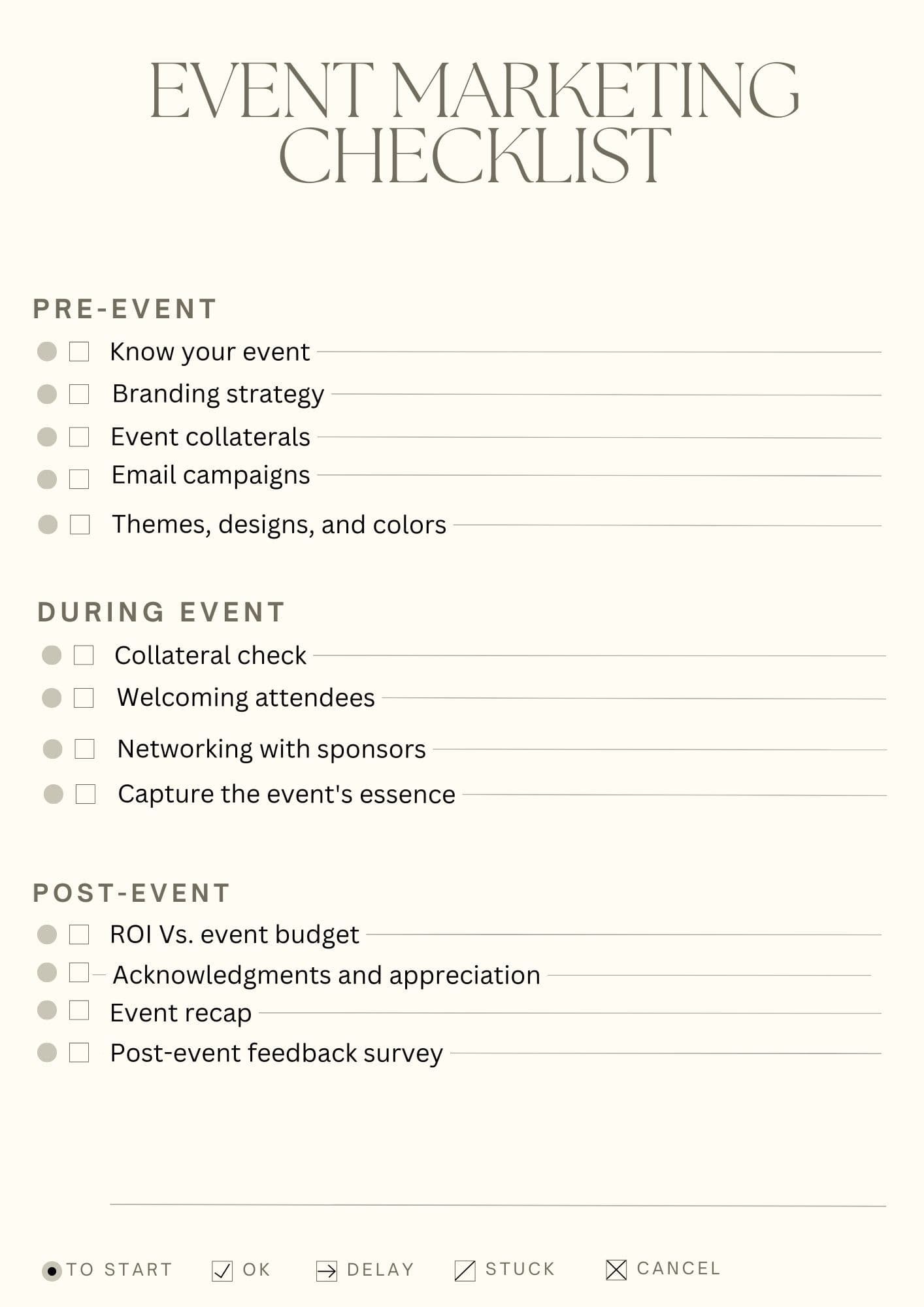- HOME
- Digital Marketing
- How to create an event marketing plan with a checklist?
How to create an event marketing plan with a checklist?
- Last Updated : February 1, 2024
- 913 Views
- 7 Min Read

Event marketing sounds kind of fancy, right? It's not only one of the best ways to generate profits and leads for your brand, but also has the added advantage of boosting your brand reputation.
But the complexities of event marketing can often exceed initial expectations, and you may have concluded already that the perfect event marketing checklist doesn't exist—but hold on! Not so fast! With over four years of experience supporting brands and exhibiting at different events, trade shows, and expos, I've finally curated the perfect event marketing checklist that you can use to get started right away. Yay!
Why is it important to create an event marketing checklist?
You can't successfully prepare, plan, execute, and complete an event without an event marketing checklist. It's as simple as that! A detailed checklist helps every event marketer align all the processes during different stages. This includes defining roles for everyone and making sure there are no last-minute rushes. Here are a few of the biggest benefits of using an event marketing checklist:
- Organizes each aspect of your event.
- Helps you stay on track.
- Helps maintain brand consistency.
- Helps keep your budget under control.
- Boost collaboration and coordination.
- Serves as a reference document so you can measure your event's success.
How to split your event marketing checklist?
You can split your event marketing checklist into three main phases:
- Pre-event
- Mid-event
- Post-event
Pre-event checklist
The pre-event marketing phase usually starts with a lot of excitement, but often fizzles out. It's easy to lose track of time here and miss out on important preparations—and that's not to mention the headache, anxiety, and insomnia you might experience as you plan your event. But that's what a pre-event marketing checklist can help you overcome. Pre-event marketing aims mainly at two things: boosting registrations and generating hype for the event. Asking yourself the following questions will help guide you to the right answers!
Quick tip: Be as creative as possible and keep the experience you want attendees to have at the top of your mind while you develop your content strategy for the event.
What is your event?
This question is very simple, but absolutely essential! What kind of event are you planning? How many attendees are you expecting? Whatever the answers are, these questions apply to any kind of event.
Before organizing your event, consider these details as they relate to the event:
- Type of event
- Purpose
- Goals and objectives
- Budget
- Location/venue
- Time and date
- Target audience
What's your branding strategy?
It's important to identify and finalize your branding strategy for the event, as you'll need to define it in order to start preparing for the event. Branding is one of the most important factors when it comes to setting your company apart from your competitors. Having the right event branding strategy helps creates a story for your company and make a more lasting impact.
Some of the most important event brand elements to focus on are as follows:
- Logo
- Slogan/tagline
- Color palette
- Typography
- Imagery
- Brand voice
- Brand story
What collateral does your event need?
Content marketing is crucial in event marketing. Without it, there's nothing you can use to promote it. A dedicated website or landing page for your event is always a good idea.
Here are a few things to do while creating your landing page for the event:
- Tell your event's story.
- Add catchy tagline.
- Plan what content collateral you'll need to support it—pop-ups, blogs, social media posters, webinars, podcasts, etc.
- Define your brand's tone.
- Select visuals for the website's design.
Once you've finalized all of these aspects, content creation is easy. As soon as the website or landing page is ready, you should create as much digital content as possible—including social media posts and emails—promote your event website, drive visitors to its landing page, and open up ticket registrations.
Creating email campaigns
Though you have many marketing channels at your disposal for promoting your event, email marketing is perhaps the most effective one. Its primary benefit is its directness. With social media or other channels, you have to wait for users to engage with your content, whereas with email marketing, you can reach your audience directly in their inboxes—which helps you create a more personal connection with your audience. Better connections lead to better conversions and better cost-effectiveness.
Event themes, designs, and colors
Your collaterals need to speak for the event. Every aspect - color, design, theme, and images used will impact your target audience. These help the visitors develop an association with the brand. Using the same brand color for all your events and sticking to a theme will create brand awareness and an emotional connection with the target audience.
Consider these before you decide on the color, theme, and design for the event.
- Warm and cool color wheel, combinations, and association
- Keep the venue in mind - indoor or outdoor, landscape, and space
- Ensure the event reflects the event's purpose.
- Identify colors that are best suitable for your industry
Mid-event checklist
You've created a first impression and can now proceed to the mid-event checklist. Now that you have taken off, we'll tell you how to fly safely.
Are you ready for the big day?
Check twice—maybe even thrice—to make sure you have copies of essential materials, including instructions, directions, contact numbers, keys, additional parking permits for VIP guests, and seating charts. Carry comprehensive guest lists with you to make sure the event goes smoothly.
How do you plan to welcome attendees?
Plan thoughtfully and provide your attendees with a warm and engaging welcome. You can also go the extra mile by doing the following to welcome them:
- Design and place the registration desk so that it's easily findable and recognizable.
- Task dedicated person with welcoming attendees.
- Give out a big and bright smile—they're still free!
- Use interactive touchscreens and tablets.
- Use pop-up booths.
- Make registration easy with an app.
- Set up visual displays that make your brand stand out.
Have you provided networking opportunities for sponsors?
Don't forget your event sponsors and partners; they have a huge impact on your events as well. Make sure you highlight them as part of your event agenda. Try to give them a speaker slot or promotion space, or add their logos to your event collateral.
Did you capture the event's essence?
Don't forget to capture the event's true essence with photos and videos. Make posts, shorts, and reels out of it. Collect feedback from attendees during the event without being intrusive.
Post-event checklist
Yes! You've successfully completed the event. It's time to celebrate. But don't forget to go through your post-event marketing checklist.
Follow up to get comprehensive feedback from your attendees, partners, and sponsors, and make sure to follow these important things after your event.
Compare your event's budget to your ROI
Analyze and calculate your financial information to compare your actual expenses against your event's budget. This will help you evaluate your event's performance.
Here are a few things you can do:
- Run all of your event-related reports and collect data.
- Analyze your forecasted and actual expenses.
- Identify the operational costs you've incurred and review them.
- Keep track of your financial progress before, during, and after the event.
- Identify deviations from your actual plans.
Following these steps will yield concrete numbers you can use to gauge how meticulously everyone has handled your event's expenses and costs, and in turn to determine how well your generated ROI served your business purposes.
Did you send out acknowledgments, appreciations, and thank-you gifts?
It's important to express your gratitude to all of your event's participants, including attendees, partners, vendors, investors, and sponsors. Send personalized emails to each contributor, acknowledging their role in the success of the event. Include an opt-in mechanism in your communication for those interested in receiving future updates.
For a more comprehensive show of appreciation, consider sharing an event summary containing essential details to remember or key takeaways. This not only reinforces the value of their participation but also provides a lasting impression of the event.
Did you curate an event recap?
Evaluate and debrief your event participants to leverage post-event engagement and sustain momentum for future opportunities. Here's a strategy for presenting your event recap:
- Share comprehensive event summaries on various social media platforms. Highlight key moments, notable achievements, and impactful experiences in a visually engaging recap that resonates with your audience.
- Craft and share key highlights from the event through various other channels. Whether through visually appealing graphics, brief summaries, or standout quotes, showcasing the most memorable aspects keeps the event alive in the minds of your audience.
- Create and share throwback videos from the event that capture its energy and enthusiasm.
- Use post-event social feeds to attract new audiences. Leverage captivating content and user-generated posts to showcase the event's positive impact to entice a wider audience for future engagements.
- Capitalize on the event's success by strategically leading with a plan for continuing conversations that nurture leads. Use post-event engagements as a foundation to foster relationships and build anticipation for future events.
Did you conduct a post-event survey?
A post-event survey is an important tool for precisely evaluating the success of your event and its alignment with your intended objectives. This survey enables you to gather valuable insights into what worked well and what didn't resonate with your event attendees.
Feedback gathered from post-event surveys serves as a cornerstone in the event marketing checklist by providing event marketers with actionable information they can use to implement changes and enhancements, ultimately shaping a better event experience for future attendees. By carefully analyzing this feedback, event organizers can refine their strategies, address pain points, and continually elevate the overall quality of their events.
As we promised, here's your ready-to-use event marketing checklist!

Now, that you know what to do in all three stages of an event, your event marketing checklist is ready and set! You can make minor tweaks to it and improve the list based on the event itself and its unique requirements. All the best for you next event!
 Keerthana Selvakumar
Keerthana SelvakumarKeerthana Selvakumar is a product marketer at Zoho. She is passionate about weaving storytelling into the world of competitive B2B SaaS marketing. You can start a conversation with her by leaving your comments for this post. Also, Keerthana is a Potterhead, who loves anime, and believes she is the actual representation of the heart in the 'Awkward Yeti!'


